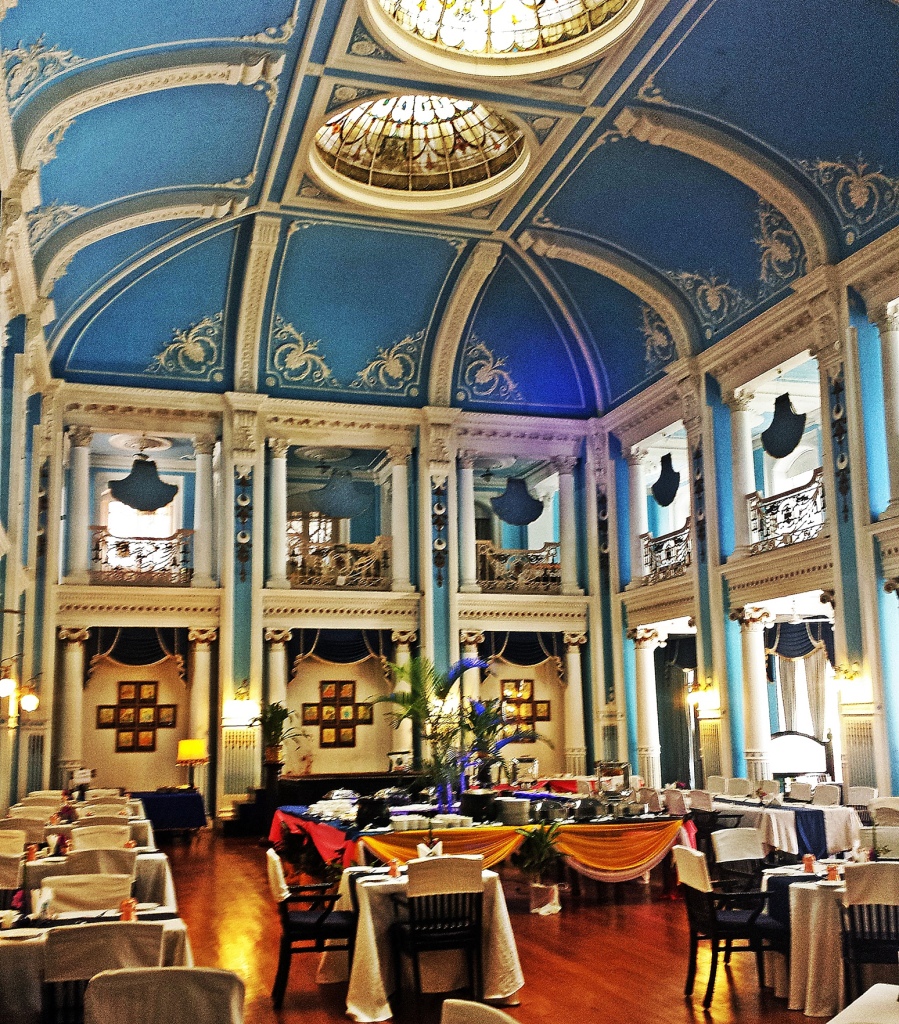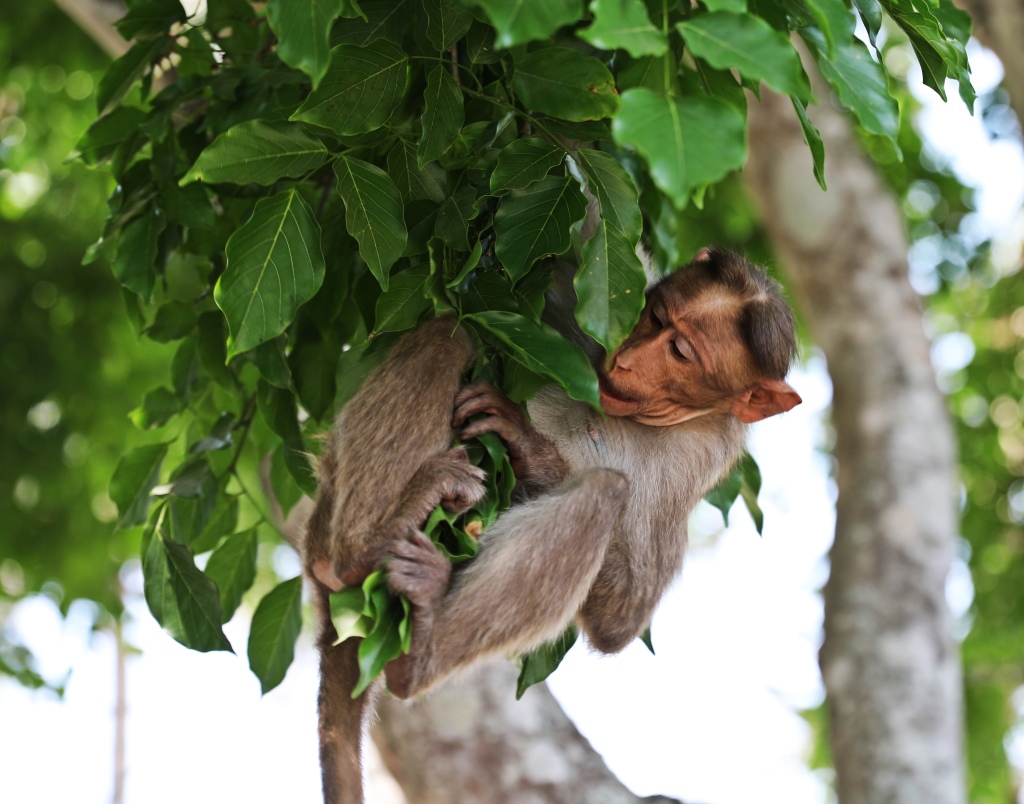The City of Palaces, Mysore (now called Mysuru) is steeped in history and is full of beautiful architectural gems. Between the ornate palaces and the regal government buildings there is much to see in Mysore.
The most beautiful and most famous building is Mysore Palace, home to the Wadiyar Dynasty. This family ruled Mysore from 1399 to 1947 which includes during the British reign. When the British ruled India most other maharajahs had to give up their power, but the Mysore Empire was allowed to remain in government as figureheads. In fact, descendants of the Maharajah still live in one section of the palace. Most of the original palace burned down in the 1800s, but a new spectacular one was built on the same spot in 1912. Built in Indo-Saracenic style, Mysore Palace is a gorgeous structure. The main building is built of fine grey granite with white and yellow accents. There are chhatris and pink marble domes on the roof, tall towers, arched doorways and multi-level windows enclosing terraces.

Mysore Palace 
Mysore Palace and East Gate 
Mysore Palace 
Mysore Palace 
Mysore Palace
Inside, the palace rooms are very grand. The most beautiful rooms are the Public Durbar Hall, Private Durbar and the Marriage Pavilion. These rooms have vaulted ceilings, ornately decorated columns and beautifully tiled floors. The hallways between these rooms have large, carved wooden doors and colourful tiled designs on the walls. There’s a large outdoor courtyard where wrestling matches once took place.

Marriage Pavilion, Mysore Palace 
Marriage Pavilion, Mysore Palace 
Marriage Pavilion, Mysore Palace 
Pillars in the Marriage Pavilion, Mysore Palace 
Wrestling courtyard, Mysore Palace 
Public Durbar Hall, Mysore Palace 
Ceiling in Public Durbar Hall, Mysore Palace 
Public Durbar Hall, Mysore Palace 
Private Durbar Hall, Mysore Palace 
Colourful hallway, Mysore Palace 
Ornate door, Mysore Palace
The palace grounds have manicured gardens with flowering hedges and shrubs and stone walkways. The entire estate is surrounded by a tall stone wall with 4 beautiful arched entry ways, each more beautiful than the last. There are many Hindu temples within the complex, two are enclosed in the palace wall. The royal family still has a herd of elephants that they keep on the palace grounds. The elephants are only used for parades and festivals, otherwise they stay in the shade and eat.

Gardens and Mysore Palace 
North Gate, Mysore Palace 
North Gate, Mysore Palace 
East Gate, Mysore Palace 
Temple and East Gate, Mysore Palace 
Temple, Mysore Palace 
East Gate, Mysore Palace 
Palace Elephants with Maggie and their keeper
Every Sunday night the palace and its entrance gates are illuminated by thousands of lights. The grounds are packed with tourists to see the gorgeous display. We’re used to having to pay an entrance fee at every site we’ve visited on our travels, but the evening light show was free!

Mysore Palace at night 
Mysore Palace at night 
Temple and North Gate, Mysore Palace 
East Gate at night, Mysore Palace 
East Gate, Mysore Palace 
East Gate, Mysore Palace
In addition to Mysore Palace, there are many other old palaces in the city. Lalitha Mahal is now a luxury hotel. It was built in renaissance architectural style with large domes on the roof and double columns surrounding a large terrace around the outside. Inside, the dining hall is a lovely blue room with a vaulted ceiling and white moldings. Walking around the busy city of Mysore, we saw many other historical and colonial buildings that are now being used as government offices and art galleries. Even the traffic circles have lovely centre monuments.
On our walk we came across an unusual scene of street-typists. Although, we shouldn’t have been surprised, as we’ve learned to always expect these peculiar street sites in India. We were impressed by how relatively clean it is in Mysore. Later we read that it is one of the top 5 cleanest cities in India.

Lalitha Mahal, Mysore 
Doorman, Lalitha Mahal, Mysore 
Lalitha Mahal and gardens, Mysore 
Dining Hall, Lalitha Mahal, Mysore 
Jagan Mohan Palace, Mysore 
Government building, Mysore 
Government building, Mysore 
Government building, Mysore 
Traffic circle, Mysore 
Government building, Mysore 
Government House,, Mysore 
Government House and garden, Mysore 
Government House and garden, Mysore 
Traffic circle monument, Mysore 
Street typists, Mysore 
Chilies, Mysore market
Chamundi Hill is small hill above Mysore with a large 17th century Hindu Temple. Chamundeshwari Temple has a tall South Indian style tower with many carvings. On the busy grounds around the temple are several statues including Nandi the bull and Mahishasura, the Hindu mythical demon. The legend says that Mahishasura could assume the form of both a human and a buffalo and was the ruler Mysore in ancient times.
There is still a large Christian community in Karnataka evidenced by the massive gothic St. Philomena Cathedral. It’s a large spires and cathedral dome are impressive.

Nandi statue and pundit, Chamundeshwari Temple, Mysore 
Chamundeshwari Temple, Mysore 
Sadhu, Chamundeshwari Temple, Mysore 
Bonnet Macaques outside Chamundeshwari Temple, Mysore 
Bull outside Chamundeshwari Temple, Mysore 
Mahishasura on Chamundi Hill, Mysore 
St. Philomena stature outside Cathedral, Mysore 
St. Philomena’s Cathedral, Mysore
Coming up next: Hampi – Ancient Stone City
For extra pics from this trip go to Gallery/Western India. For extra pictures from other blogs go to Gallery at monkeystale.ca
To read about more of our adventures go to Destinations.
If you like what you read, please comment or share it using the links below.
Wow. Such amazing palaces! Thank you for sharing the beauty of Mysore, another place added to my bucket list (which is getting longer every time you post a blog entry! Haha). Do keep them coming though, I love reading about your experiences and travels 🙂 Safe and happy travels!
LikeLiked by 1 person
Wow. Such amazing palaces! Thank you for sharing the beauty of Mysore, another place added to my bucket list (which is getting longer every time you post a blog entry! Haha). Do keep them coming though, I love reading about your experiences and travels 🙂 Safe and happy travels!
LikeLiked by 2 people
Thank you Carl. The palace was far more beautiful than we expected and is definitely worth a visit. Your list is getting as long as ours!
LikeLiked by 2 people
WOW! That place is spectacular!! I don’t think I’ve ever seen architecture that breathtaking!! You are seeing some amazing places… 🙂
LikeLiked by 2 people
Thank you, yes the palace was absolutely breathtaaking. It far exceeded our expectations.
LikeLiked by 2 people
Wow what a fabulous post with so many great photographs. We already knew we had unfinished business in India but this place has to be added to our list! Our other comment would be – we certainly haven’t been anywhere in India that was as clean as Mysore!
LikeLiked by 2 people
Thank you so much! Yes, definitely visit Mysore, but don’t put high expectations on the cleanliness. We didn’t actually believe it was top 5, not as clean as Vizag or Shimla, but it was clean for India. The Palaces and other buildings though are truly beautiful.
LikeLiked by 1 person
Compelling images made me feel like I was touring the city along with you! Wonderful!
LikeLiked by 1 person
Thank you so much Sandra. There were so many interesting palaces and colonial buildings making it easy to take great pictures.
LikeLike
I need to revisit the Mysore palace because when I visited a couple of years ago, they didn’t allow the cameras and mobile inside. I was very disappointed. It’s good that now they are allowing.
LikeLiked by 1 person
Yes, we were surprised that they let cameras inside now, and there was no extra fee! It’s so gorgeous inside, we were very happy to have a camera.
LikeLike
Mysore Palace looks absolutely amazing! Even the gate is gorgeous. The illumination somehow reminds me of Tivoli Garden in Copenhagen. Perhaps, the park’s owner took inspiration from this palace 🙂
LikeLiked by 1 person
Maybe, I’ve never seen it but now I will go look it up on-line. 😊 Maggie
LikeLike